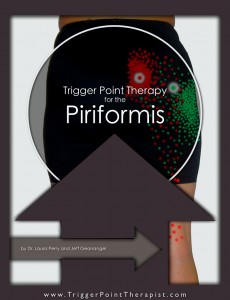Dr. Travell refers to the gluteus minimus as the “Psuedo-Sciatica” muscle because its trigger points can refer pain that mimics the symptoms associated with true neurological sciatica. I can’t overemphasize how important it is for a therapist that regularly sees low back and hip pain complaints to know this muscle and its trigger points like the back of their hand.
Even though it’s a small muscle, its numerous trigger points have a very large distribution of referred pain. The referred pain generated from these trigger points is notorious for activating satellite trigger points in the tensor fascia latae, hamstrings, quadriceps, gastrocnemius, and peroneal muscle groups.
Gluteus minimus pain is often so excruciating, and its source so well hidden, the many people that suffer from it resort to unnecessary and ineffective surgeries out of desperation. There are no words to describe their elation when my fingertips find and resolve the source of the pain that has dominated their lives. It should be noted, though, that gluteus minimus pain complaints are generally very complex disorders involving many muscle groups, so the therapist really needs to take a comprehensive approach to obtain lasting pain relief for their client.
The Gluteus Minimus Muscle
Anatomy & Biomechanics: The gluteus minimus, as its name suggests, is the smallest of the three gluteal muscles and lies beneath the other two muscles in the buttock region. This muscle shares almost identical functioning with the gluteus medius muscle, namely stabilizing the pelvis during walking or running and abducting the thigh when the leg is not weight bearing.
Like the gluteus medius, the minimus has a fan-like (or radial) structure with two fiber divisions; the thicker and compact anterior fibers and the flatter, but more spread out, posterior fibers.
Synergistic Muscles: The following muscle groups share similar biomechanical functionality with the gluteus minimus muscle and may become overloaded if that muscle is unable to perform its workload due to trigger point activity or injury:
- The gluteus medius and minimus muscles are functionally (and sometimes anatomically) one muscle group, so to say they are synergists is an understatement.
- The tensor fascia latae muscle assists in both hip abduction and medial rotation.
The Gluteus Minimus Trigger Points
As shown in diagram below, the gluteus minimus muscle can harbor up to six trigger points, two in the anterior fibers, and two to four in the posterior fibers. All the trigger points in this muscle lie deep in the buttock region, underneath gluteus maximus and medius muscles.
- The two lateral trigger points in the anterior fibers can be found in vertical alignment just a few inches above the hip joint.
- The posterior trigger points (in the posterior fibers) lie in a radial pattern that follows the arc of the hip crest, but three or four inches below it.
Gluteus Minimus Muscle Pain
The diagram above also shows the referred pain patterns associated with the gluteus minimus trigger points.
- The two lateral trigger points produce a referred pain pattern that is commonly termed “side sciatica” because it is projected to the outside aspect of the buttock and may extend all the way down the outside of the leg to the ankle.
- The posterior trigger points project a similar sciatica-type pattern of pain down the leg except that it is located on the back of the buttock and thigh, and doesn’t extend past the calf region.
What Causes Gluteus Minimus Trigger Points?
The following events or activities may overload or aggravate the gluteus minimus muscle and cause activation or reactivation of its latent trigger points:
- Limping because of a lower leg or foot injury
- Walking or running on uneven ground
- Intramuscular injection in the buttocks
- Prolonged immobility such as driving a car long distances
- True Sacroiliac Joint Dysfunction
- Sitting on a wallet
(For more information on the various causes of trigger points, please see Comprehending the Cause of Trigger Points.)
Gluteus Minimus Symptoms & Disorders
Clients with trigger point activity in the muscle group may report or demonstrate the following symptoms and clinical findings.
- Pain in buttock, hip, posterior and/or lateral thigh and calf regions
- Hip pain while walking (causing limp)
- Pain while rising from a chair
- Pain may be constant and excruciating, unaffected by positioning
- Hip adduction, such as sitting with the affected leg crossed over the other leg, is limited by pain
The Gluteus Minimus – Quadratus Lumborum Connection
Referred pain from QL trigger points is an all too common cause of satellite trigger point activity in the gluteus minimus. Often, a phenomenon that I call “piggy-backing” occurs between the QL and the gluteus minimus (and gluteus medius) trigger points, in which the referred pain patterns become neurologically integrated. Thus, during pressure release of the QL trigger points, the client will experience referred pain from both QL and gluteus minimus trigger points.
Treatment of Gluteus Minimus Trigger Points
Most pain presentations that involve the gluteus minimus are extremely complex cases. For a therapist to have any chance at creating long-lasting pain relief in these cases they will need to address many trigger points in many muscle groups, which is why I prefer to use (and teach) comprehensive treatment protocols. As most of these cases are chronic in nature, you should expect that it will take multiple sessions with a client to achieve satisfactory results.
For more information on the gluteus minimus trigger points, and for step-by-step instructions for releasing them, you can purchase the Trigger Point Therapy for the Gluteus Minimus Video Download or the Trigger Point Therapy for the Gluteus Minimus iPad Booklet.
Click on the image below to watch an excerpt from the Gluteus Minimus Trigger Points video on YouTube:
Related Articles:
- Piriformis Trigger Points: Double Trouble
- The Quadratus Lumborum Trigger Points: Masters of Low Back Pain
- How to Release the Gluteus Medius Trigger Points (Video)
- The Hamstring Trigger Points: Hiding in Plain Sight
Related Instructional Videos:






